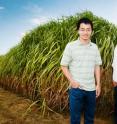Testing the water for bioenergy crops
Many energy researchers and environmental advocates are excited about the prospect of gaining more efficient large-scale biofuel production by using large grasses like miscanthus or switchgrass rather than corn. They have investigated yields, land use, economics and more, but one key factor of agriculture has been overlooked: water. "While we are looking for solutions for energy through bioenergy crops, dependence on water gets ignored, and water can be a significant limiting factor," said Praveen Kumar, the Lovell Professor of civil and environmental engineering at the University of Illinois. "There are many countries around the world that are looking into biofuel energy, but if they are adopting these (large grasses) into their regular policy, then they need to take into account the considerations for the associated demand for water."
Kumar led a study, published in the Proceedings of the National Academy of Sciences Early Edition, detailing effects to the hydrologic cycle of large-scale land conversion, both now and as growing conditions change in the future.
Miscanthus and switchgrass have a very different above-ground foliage structure from corn -- more surface area and much denser growth. This is good for maximizing the amount of biomass that an acre of land can produce, but it also increases water use. Miscanthus and switchgrass intercept light and rain differently from corn, and lose more water through transpiration, causing them to pull more water from the soil. The result of large-scale adoption would be a reduction in soil moisture and runoff, but an increase in atmospheric humidity.
"All these together account for the changes in hydrology, just from land-use change," said Kumar, who also is affiliated with the department of atmospheric sciences. "Then, if you impose further -- higher carbon dioxide in the atmosphere, higher temperatures and changes in rainfall patterns -- they add further modulation to the water use pattern."
Kumar's group used a sophisticated model it developed to study crops' fine sensitivities to temperature and carbon dioxide changes in the atmosphere. The model incorporates the acclimation response of plants to changing climate.
Using their predictive model, the researchers found that the net water use will increase further as a result of rising temperatures and carbon dioxide. Higher levels of carbon dioxide alone make the plants more water-efficient, since their pores are open less time to absorb carbon dioxide. However, rising temperatures counteract this effect, as the plants will transpire more while their pores are open, losing more water than they save.
This additional water loss compounds the increase in water usage from land conversion. In the U.S. Midwest, rainfall should remain sufficient to meet water demand, according to Kumar. However, areas that rely on irrigation could find they have less water to meet higher demands, which could increase the net cost of large-scale land conversion and put pressure on already stressed water resources.
"If we're going to solve energy problems through bioenergy crops, there are collateral issues that need to be considered," Kumar said. "Water is a significant issue. It's already a scarce resource across the globe, and the need for it is only going to increase. The cost of that should be factored in to the decision making."
Graduate student Phong V.V. Le and former postdoctoral researcher Darren Drewry (now at the Max Planck Institute in Germany) were co-authors of the paper.
The National Science Foundation and the Vietnam Education Foundation supported this work.
Source: University of Illinois at Urbana-Champaign
Other sources
- Study: Water a factor for bioenergy cropsfrom UPITue, 30 Aug 2011, 6:30:31 UTC
- Study: Water a factor for bioenergy cropsfrom UPITue, 30 Aug 2011, 1:00:26 UTC
- Testing the water for bioenergy cropsfrom Science DailyMon, 29 Aug 2011, 23:30:35 UTC
- Testing the water for bioenergy cropsfrom PhysorgMon, 29 Aug 2011, 20:31:25 UTC

